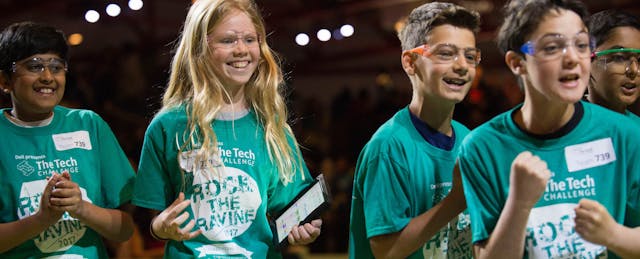It started with an underwhelming science fair—the type we’re all familiar with: students standing next to handmade posters, listlessly describing their projects, usually alone. While some of the projects were impressive, for onlooker Greg Brown, a former engineer, this just wasn’t the way real engineering worked. So he set about to create a more authentic experience, partnering with the Tech Museum of Innovation in San Jose to launch The Tech Challenge, a program that has served over 20,000 students since it launched thirty years ago.
The Tech Challenge has come a long way, with close to 700 teams competing this year, and big-name sponsors including Dell, Intel and Cisco. During the annual April competition, student participants, as young as 4th graders, tackle real-world design challenges like how to build earthquake-proof structures and get arctic explorers safely across ice.
While the program has grown and evolved, the original principles of the competition remain largely the same: to give all students the opportunity to build not just technical skills, but to work like engineers—collaborating with peers, documenting their processes, and presenting their findings.

Putting the humanities back into STEM
For Abby Longcor, Senior Director of the Tech Challenge, that’s what really sets the program apart: the interdisciplinary approach to engineering. “We often neglect to tell students that reading, writing and communicating are just as necessary to success as technical skills,” Longcor explains. “In a traditional school, subjects aren’t integrated. Students are able to say, ‘Oh I’m good at math; I don’t need these other skills.’ That’s true to an extent, but if you’re good at math and can’t communicate, it’s going to be hard to be successful in any role.”
That's why the competition is designed to give students a well-rounded experience involving a broad set of academic and non-academic skills. Teams are judged across three categories: how well the designed product works, the quality of students’ documentation and their verbal justification. Come April, students present their projects to a panel of professional engineers, often after a full year of preparation guided by an adult advisor.
Lisa Stone, a veteran teacher at the Bullis Charter School in Los Altos, Calif., began participating in the Tech Challenge more than ten years ago as a team advisor. She took on the role despite her lack of engineering experience, but it turned out that her English Language Arts background came in handy. “Because I didn’t have the content knowledge, the projects were totally student-driven,” Stone explains. This is where personalization comes in: students are figuring out for themselves how to problem-solve, and doing it in the ways that work for them as learners.
Having said that, as an ELA teacher, Stone says there were still plenty of opportunities within the program for her to provide guidance, especially considering the importance of writing and speaking skills to success. During the Q&A portion of the competition, for example, students have to present their rationale verbally to a panel of judges. As an advisor, Stone supported students in creating engaging presentations and provides opportunities for students to practice explaining their rationale, two skills she recognizes are necessary for success in any field.

Not your typical science fair
But for Stone, the best part of the program is the sense of teamwork it fosters—what she deems “radical collaboration.” She recalls working with a small, all-girl team that was struggling to figure out how to bend a thumbtack at the right angle. “I walked in and they had all just dropped to the floor because they were so frustrated. They were staring at the ceiling saying, ‘The solution to this has to be obvious!’”
Eventually they got it, but to Stone, the key was that they worked together through a difficult problem collectively. “It’s the understanding and teamwork that comes out of it. When my students get into teams now, we encourage them to remember that everyone approaches a problem differently, and that’s a good thing.”
Longcor agrees that the benefits extend beyond academics. “It’s teaching life skills: being able to listen to others and hear their ideas, to think critically, and to work with others with different points of view.”
Want to shake up your local science fair? Some tips from the pros
1. Make it cheap
When it comes to participating in the Tech Challenge, the program strives to ensure no one is left out. The registration fee is waived for low-income students, and the program purposely assigns problems with solutions that can be designed for under $50. Having said that, Longor acknowledges not every team is coming in with the same resources. And while they don’t encourage spending a lot of money, it’s inevitable that some teams outspend others.
2. Make it flexible
Although students need to carefully document their design process, there are no guidelines around what that should look like. Stone says while some students go into the competition guns blazing, with computers and elaborate online presentations, her students opted for a decidedly old school approach. They did manage electronic logs into which they imported images and such, but they combined that with hand drawn and hand generated notes and eventually compiled everything in hard copy in binders to present to the judges. There’s also flexibility around developing teams. Although students commonly participate with teachers or through after-school programs, students can also sign up independently with friends and family. All they need is an advisor over the age of 18.
3. Let students choose (but don’t be afraid to push them out of their comfort zones)
Stone has led both voluntary and mandatory Tech Challenges, and she says both experiences have value. Allowing students to opt-into the program gives them a sense of engagement and autonomy. In a mandatory challenge, where say all students across a grade-level participate, she has seen hesitant students rise to the challenge. “They’re engaging in a task they’ve never worked on before, and that’s really empowering,” she recalls. “It helps them understand there may be something they love they’ve never tried before.”
4. Be open-minded
As is typical with project-based learning, the Tech Challenge can—and often will—get messy. “In 2015, we designed earthquake-safe buildings,” Longcor remembers, “and there were A LOT of falling down (prototyped) buildings, kids running around in hard hats. Students were having a blast and learning a lot, but it doesn’t look like students sitting down learning…it can look a little chaotic.” But when it comes to creating a well-rounded students, that sounds like a fair trade-off.


